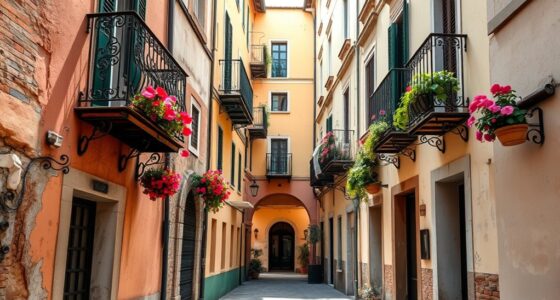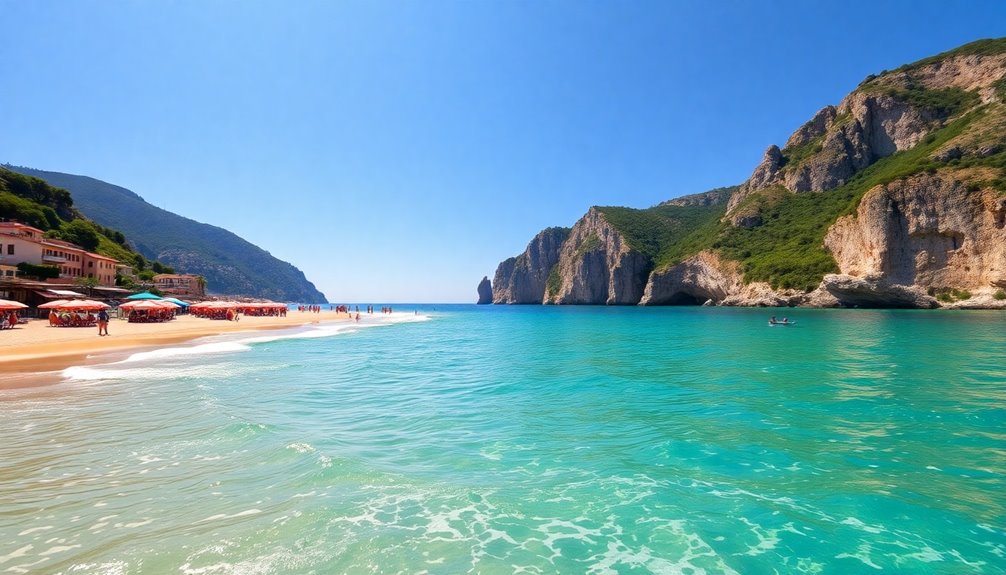A day trip to Paestum lets you step back into ancient history. You can reach this UNESCO World Heritage site easily by train or car from Naples or Salerno. Once there, explore the impressive Greek temples, including the Temple of Neptune and the Temple of Hera. Don't forget to visit the National Archaeological Museum to see incredible artifacts like the Tomb of the Diver. Afterward, treat yourself to local dishes, such as Gnocchi alla Sorrentina. As you stroll through the site, admire the scenic views and ancient walls. There's so much more to discover about your visit! A trip to this remarkable destination also pairs perfectly with visiting Pompeii and Herculaneum, two other nearby archaeological wonders that offer further insights into Italy’s rich history. While Paestum showcases stunning Greek influence, Pompeii and Herculaneum reveal the daily life and tragic demise of Roman cities frozen in time by Mount Vesuvius’ eruption. Together, these sites make for an unforgettable journey through antiquity.
Key Takeaways
- Paestum is accessible by train (from Naples or Salerno), bus, or car, making it easy for a day trip.
- Visit the well-preserved Greek temples, including the Temple of Poseidon and Temple of Hera, showcasing ancient architectural beauty.
- Explore the National Archaeological Museum in Capaccio-Paestum, featuring treasures like the Tomb of the Diver and various artifacts.
- Savor local culinary delights such as Gnocchi alla Sorrentina and Polpo alla Luciana in nearby restaurants after your visit.
- Consider nearby attractions like Salerno or mozzarella farms to enhance your day trip experience.
Getting to Paestum
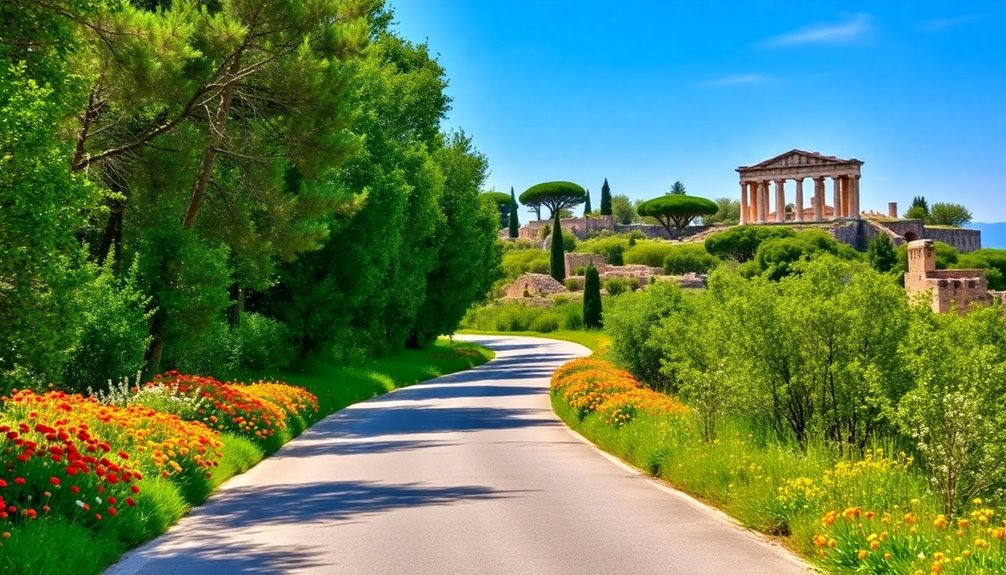
Getting to Paestum is straightforward, whether you choose to travel by train, bus, or car.
If you opt for the train, you can catch Line R from Naples or local trains from Salerno. It'll take you about 1.5 hours from Naples or just 30 minutes from Salerno, with around 18 trains running daily. The closest station is Stazione di Paestum, and it's a quick 15-minute walk to the archaeological park. Additionally, you can find direct fast trains available from Rome to Salerno, which enhances accessibility.
Alternatively, you might prefer the bus. CSTP Bus 34 runs frequently from both Salerno and Naples, taking about 1 hour from Salerno and 85 minutes from Naples. The closest bus stop is conveniently located near the park, making it a hassle-free option.
If driving's your style, take the AutoStrada A3 Motorway to Battipaglia and exit toward SS18. You'll cover around 109 km from Naples International Airport, roughly taking 1 hour and 39 minutes. Additionally, Paestum is a UNESCO World Heritage Site, which highlights its significance as a historical destination.
Plus, you'll find ample parking facilities near the park, perfect for a scenic drive through the Campania region. Just remember, there's no metro service to Paestum, so stick with trains or buses for your journey.
Historical Background

After you've made your way to Paestum, you'll want to explore its rich historical background. Founded around 600 BC by Greek colonists from Sybaris, this ancient city was originally named Poseidonia, after the god of the sea.
The settlers, likely Achaeans, Dorians, or Troezenians, established a thriving Greek settlement that enjoyed a democratic system for roughly two centuries.
However, by 400 BC, the Lucanians took control, and the name changed to Paestum. The city endured Lucanian rule until Alexander, king of Epirus, defeated them around 332 BC.
Roman conquest came in 273 BC, transforming Paestum into a Latin colony. The city initially prospered under Roman rule, especially during the Second Punic War, but its fortune waned over time due to shifting trade routes and flooding. Today, it features three ancient Greek temples that are well-preserved, showcasing the city's architectural significance in the [Doric order.]
Eventually, Paestum was abandoned in the Early Middle Ages. Rediscovered in the 18th century, it features well-preserved Greek temples and Roman structures, including remarkable frescoes and the Tomb of the Diver.
Today, it stands as a UNESCO World Heritage site, inviting you to delve into its storied past.
Exploring the Archaeological Site
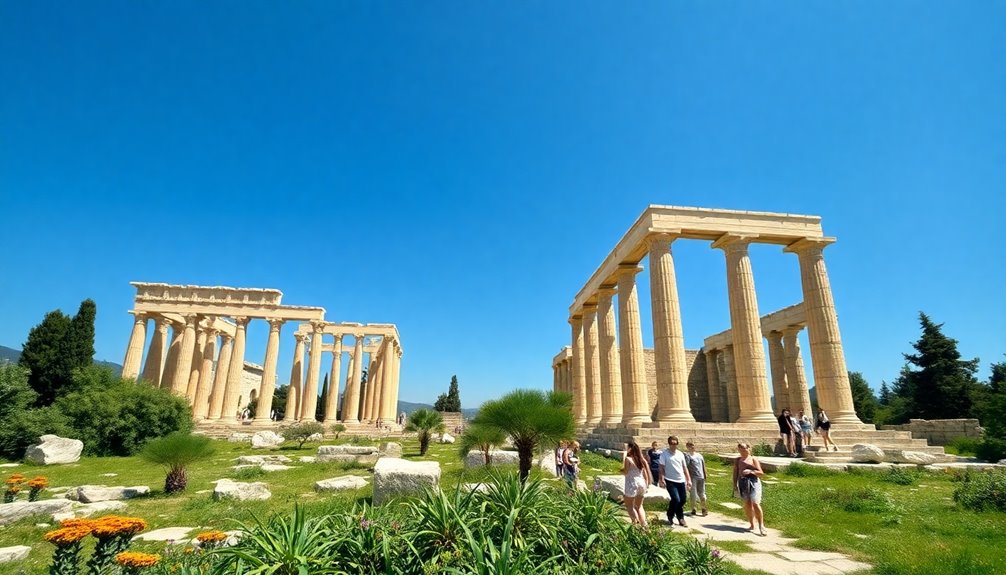
Stepping into the archaeological site of Paestum is like walking through a time capsule of ancient history.
You'll be greeted by the majestic Temple of Poseidon, the largest temple here, with dimensions of 195 by 80 feet. This mid-5th century BC structure is one of the best-preserved Doric temples in the world. As you explore, you might ponder its original dedication—once thought to be Poseidon, but possibly Apollo or Zeus. The temple is a remarkable example of ancient Greek architectural innovation.
Don't miss the Temple of Hera I, the oldest of the trio, built around 550 BC. Its 50 columns tell stories of devotion, and you can easily spot its mistaken identity as a Roman basilica. This temple was initially thought to be a Roman public building due to its size and structure.
Nearby stands the Temple of Hera II, built around 450 BC, retaining most of its entablature and providing a striking comparison to the Temple of Poseidon.
Lastly, take a moment to admire the smaller Temple of Athena, dedicated to the goddess of war and wisdom.
As you wander among these impressive structures, you'll feel the weight of history and the artistry of Greek architecture surrounding you.
Visiting the Site
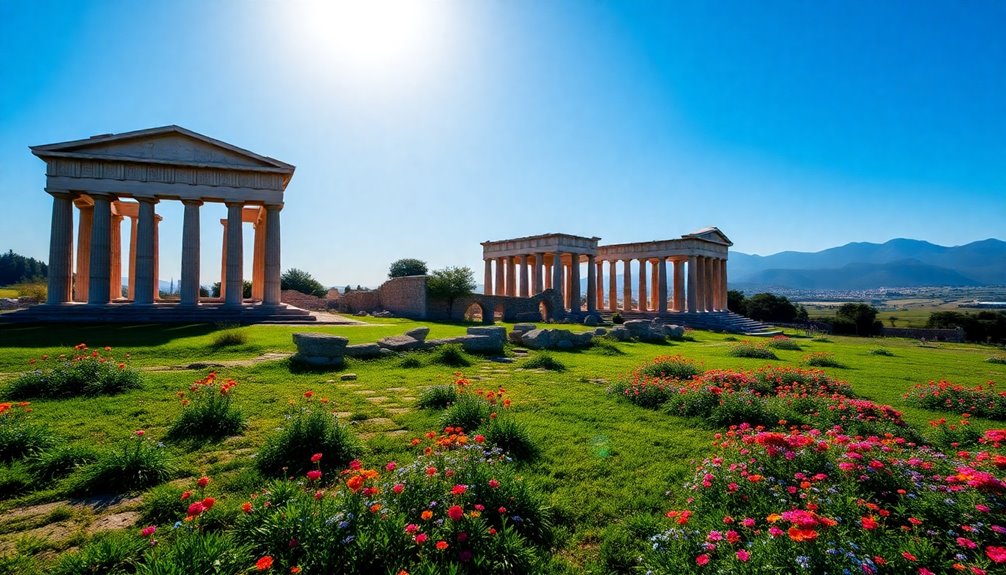
A visit to Paestum offers an unforgettable journey into the heart of ancient Greece, where remarkable temples stand as testaments to a rich historical legacy. The site, a UNESCO World Heritage Site, showcases the charm and richness of Greek civilization. Paestum is known for its three well-preserved ancient Greek temples, including the impressive Temple of Neptune.
To get here, you can take a regional train from Salerno, which takes about 30-35 minutes. Once you arrive, it's just a 1 km walk to the archaeological park. If you prefer driving, take the A3 highway to the Battipaglia exit, with a total travel time of around 45 minutes. Parking is available near the site.
When planning your visit, keep in mind the opening hours. From April to June, the site is open from 8:30 AM to 7:30 PM, while from October to March, it closes at 5:00 PM.
Admission fees range from €10 to €15 depending on the season, and you can purchase tickets online or at the entrance. It's advisable to buy skip-the-line tickets during peak seasons, especially if you want to join a guided tour with an archaeologist.
As you explore, remember to wear comfortable shoes and bring sunscreen. Enjoy the stunning scenery and the historical ambiance that Paestum has to offer!
National Archaeological Museum

Nestled in Capaccio-Paestum, the National Archaeological Museum offers a fascinating glimpse into the ancient city of Poseidonia, known today as Paestum. Established in 1952, this state museum became autonomous in 2015 and is one of Italy's major "on-site" museums.
You'll find a diverse collection of archaeological treasures that include inscriptions, votive terracotta figurines, and stunning painted vases. One of the highlights is the Tomb of the Diver, a unique painted tomb dating back to the 5th century BC, which features a painted lid depicting a young man diving into water.
The museum houses roughly five hundred painted slabs and fragments from Lucanian period tombs, showcasing the rich artistry of the era. The exhibition is thoughtfully divided into seven sections, allowing you to trace the history of the Greek, Lucanian, and Roman influences in the area. Additionally, the museum is recognized as a UNESCO World Heritage site due to its proximity to the archaeological ruins.
Don't miss the Metopes Hall and Sanctuary Hall, which were added during extensions in the late 20th century. The museum grounds also feature the restored Garden of Hera, inviting you to enjoy a serene moment in a beautiful setting.
Open daily from 8:30 am to 7:30 pm, it's an enriching stop for anyone interested in ancient history.
Local Cuisine and Delicacies

After exploring the treasures at the National Archaeological Museum, your journey in Paestum wouldn't be complete without savoring the local cuisine. The area boasts a rich array of traditional pasta dishes that you'll love.
Try *Gnocchi alla Sorrentina*, a baked delight with potatoes, tomato sauce, and smoked provola cheese. If you're in the mood for something lighter, *Spaghetti alla Nerano* combines zucchini, garlic, and provolone del Monaco for a fresh flavor.
Seafood lovers will rejoice with options like *Polpo alla Luciana*, featuring octopus cooked in a savory tomato sauce, or *Linguine ai Frutti di Mare*, packed with mixed seafood.
For meat enthusiasts, don't miss out on the locally preserved *Prosciutto Cotto* and *Salami*, perfectly paired with regional cheeses.
If you're leaning towards vegetarian, you'll find dishes laden with fresh herbs and vegetables, such as stuffed squash blossoms or artichokes prepared in various styles.
Scenic Views and Surroundings
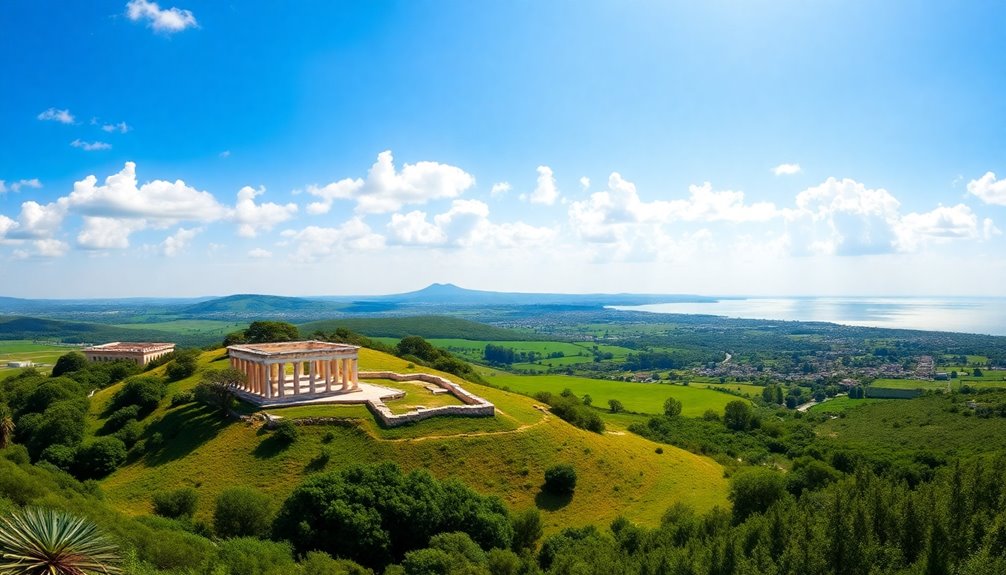
Offering breathtaking vistas, the three Greek temples of Paestum stand proudly against the Southern Italian sky, each visible from the others. The cream-colored stone of these well-preserved structures contrasts beautifully with the vibrant blue sky and the tall umbrella pines surrounding them.
As you approach the Temple of Neptune, its striking Doric columns made from golden travertine capture the light, creating a captivating display of shades.
The landscape surrounding Paestum adds to its charm. Located less than an hour's drive south of Salerno, the site boasts green lawns and offers stunning views of the ancient city walls, which stretch approximately 4.75 km. From these walls, you can gaze out at the sea and the flat terrain peppered with grassy patches.
A pedestrian road (SP276) runs alongside the archaeological park, providing free views of the temples and easy navigation for visitors on foot.
As you explore, consider climbing to a viewing platform to admire architectural details or enjoy the vivid tomb paintings discovered nearby. The combination of ancient ruins and natural beauty makes Paestum a visual feast you won't want to miss.
Additional Activities and Tips

Enhance your day trip to Paestum by exploring the myriad of activities and attractions nearby. Consider stopping in Salerno on your way back, where you can admire the Cathedral, stroll along the Corso for shopping, and enjoy the lungomare's breathtaking sea views.
Don't miss out on visiting mozzarella farms like Vannulo, where you can tour the facilities and sample exquisite buffalo mozzarella.
If you're feeling adventurous, head to Agropoli for a sailboat aperitif, or explore the charming Amalfi Coast towns, such as Positano and Amalfi, for a broader experience.
For a deeper dive into the region's history, join a guided archaeological tour, or hire a private driver for convenience.
To enrich your culinary experience, consider a food and wine tour or cooking class focused on local cuisine. If you enjoy hiking, guided tours in the surrounding area offer stunning views and unique perspectives.
Remember to check ticket prices and museum hours, and plan for potential traffic delays along the Amalfi Coast.
Lastly, savor local products, especially buffalo mozzarella, and dine at recommended restaurants in Salerno for an unforgettable end to your day.
Frequently Asked Questions
What Is the Best Time of Year to Visit Paestum?
The best time to visit Paestum's during May to October. You'll enjoy warm weather, ideal for outdoor activities. June's particularly pleasant, but September offers fewer crowds while still being warm and enjoyable.
Are There Guided Tours Available for the Archaeological Site?
Yes, you'll find guided tours available for the archaeological site. They're led by certified guides in multiple languages, offering various durations and features, including visits to major temples and skip-the-line access for convenience.
Is Parking Available Near the Archaeological Site?
Yes, you'll find parking available near the archaeological site. Several paid options are within walking distance, costing €5 for daytime. Some areas offer shaded spots, but they can get busy during peak times.
Can I Bring Food and Drinks Into the Site?
You can't bring food and drinks into the site. It's best to plan your meals at nearby restaurants instead. Enjoy the local cuisine while ensuring you follow the site's rules for a hassle-free visit.
Are There Restroom Facilities at the Archaeological Site?
Yes, there're restroom facilities at the archaeological site. You'll find modern restrooms at the entrance, ticket office, and museum. Using the museum restrooms is recommended for better conditions and they're free before entering the paid area.
Conclusion
A day trip to Paestum offers a perfect blend of history, culture, and stunning views. You'll wander through ancient ruins, savor delicious local cuisine, and soak in the beauty of the surrounding landscape. Don't forget to explore the National Archaeological Museum for a deeper understanding of this fascinating site. With so much to see and do, you're bound to leave with unforgettable memories. So pack your bags and get ready for an adventure in Paestum!



